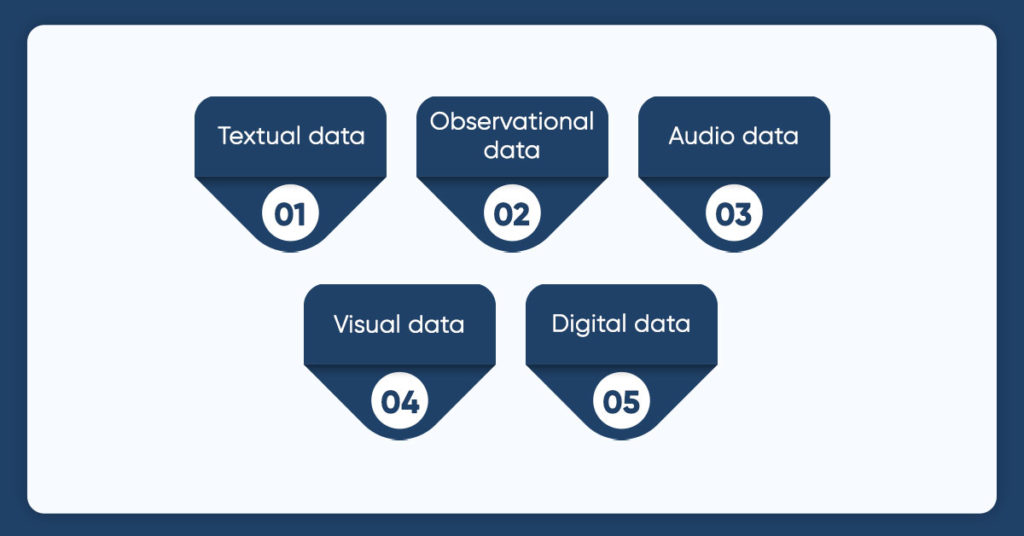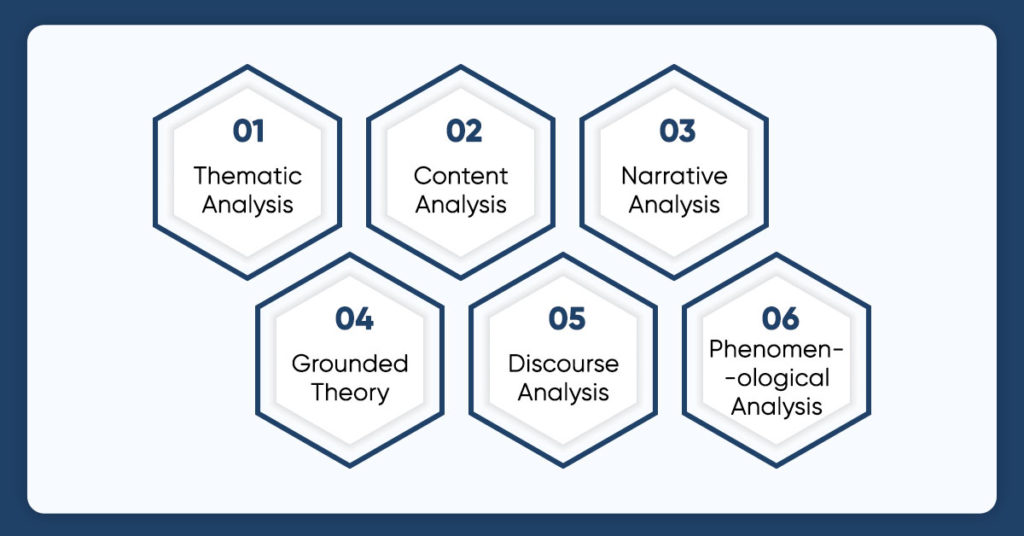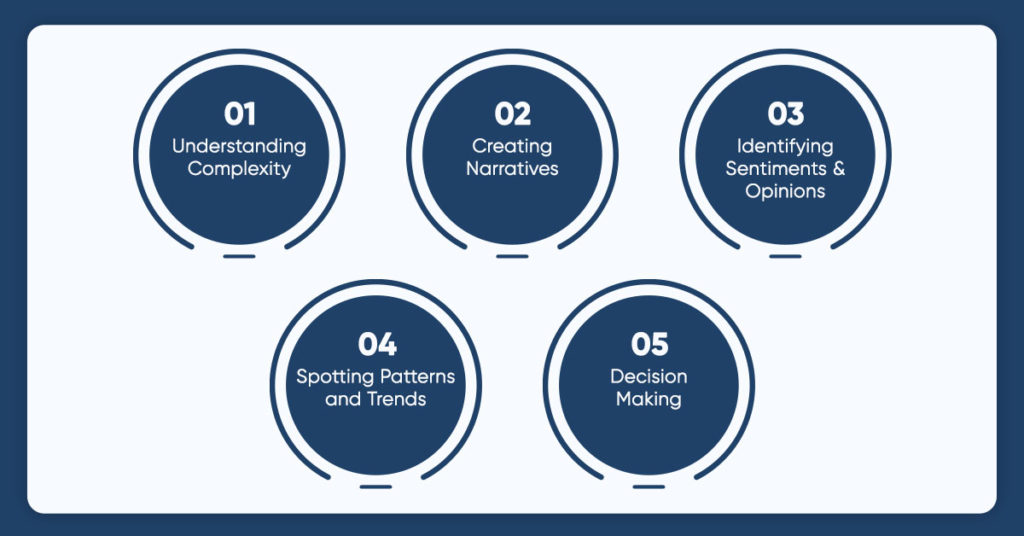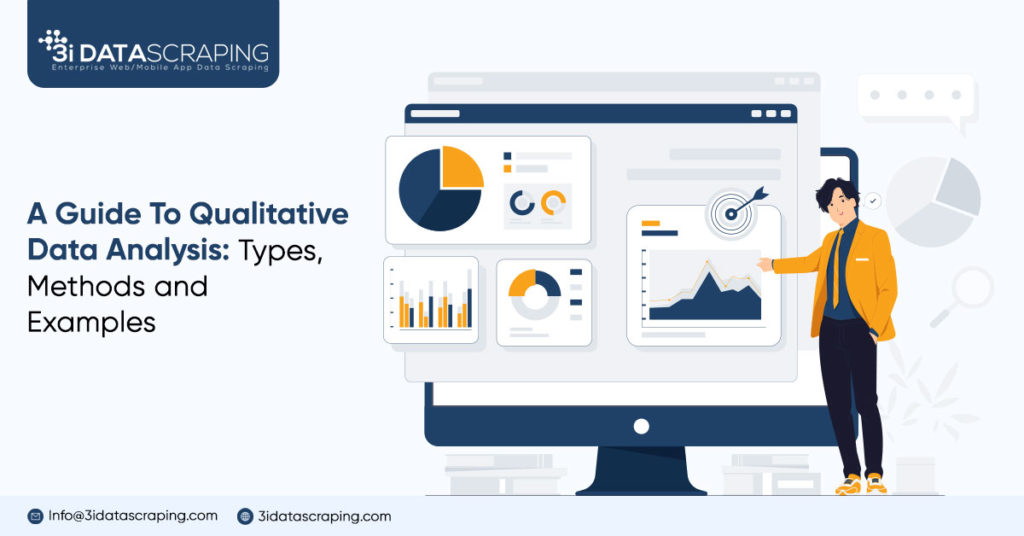Qualitative Data Analysis: Types, Methods and Examples
- January 22, 2024
Our achievements in the field of business digital transformation.









Introduction
Data is not just about numbers and stats. It also includes stories and patterns. The numbers and stats form the quantitative data, while texts, pictures, and other types get counted as qualitative data. This data provides an in-depth analysis that holds significant value. Whether you are an experienced data analyst or even if you’re a new learner, qualitative data can help you notice and understand human experiences, chats, and other observations. This blog will guide you on how to analyze qualitative data. It will explain the different analysis methods and types of qualitative data and provide examples that will guide you to draw meaningful results. So, forget about those Excel sheets and search deeper, where each word and tiny detail can reveal pretty exciting information.
What is Qualitative Data?
Qualitative data is information that isn’t about numbers but instead describes the features, qualities, or traits of something. This data is in the form of text, pictures, sound, or videos and helps to study and understand the details, like how people act, feel, and think in different situations. Qualitative data provides deeper insights into patterns, motivations, or perspectives, and it is mainly collected through methods such as interviews, observations, or focus groups. In contrast to quantitative data (e.g., numbers, measurements, and statistics), qualitative data allows researchers to explore the ‘why’ and ‘how’ behind specific trends and situations, offering a more comprehensive understanding of a topic.
What is Qualitative Data Analysis?
Qualitative Data Analysis is a systematic process to understand non-numerical data and draw out helpful details, trends, and ideas. This analysis helps us understand what the gathered data means and stands for. Analysis like this is generally used to understand better complex ideas, people’s views, and experiences and to find new thoughts for more research.
Types of Qualitative Data

Non-numerical data of various types can be collected and examined to gain deeper insights. The usual types are:
Textual Data: Written or spoken words from sources like interviews, transcripts, documents, open-ended survey responses, diaries, or social media posts.
Observational Data: Collecting details by watching people, actions, or happenings just as they are. It could include jotting down thoughts, describing, or even drawing pictures.
Audio Data: This refers to recorded talks, be they formal interviews, casual chats, speeches, or any other kind of spoken word, that can be studied to find topics, trends, or repeated elements.
Visual Data: This includes pictures, photos, drawings, or videos to understand better how people act, how they feel, and the settings they are in.
Digital Data: This refers to using data from online places like social media chats, website stats, and content made by regular users, which can be studied in detail to find common patterns and emerging trends.
Qualitative Data Analysis Methods

There are different ways to study qualitative data analysis methods, each with strengths and weaknesses and varying difficulty levels. Here are some of the main ones:
Thematic Analysis: This method spots, assesses, and interprets themes within qualitative data. It is about accurately identifying and comprehending both themes and concepts.
Example
Imagine you’re exploring college students’ diets. You interview students and gather information about their meals, nutrition attitudes, and struggles. You find common themes in their responses like ‘budget issues’, ‘time management’, ‘ease of access’, ‘peer pressure’, and ‘awareness of health’. These themes provide insights into what influences students’ eating behaviors.
Content Analysis: Content Analysis helps find, measure, and examine the occurrence of certain aspects within a data set. It’s used mainly with text but can also work with sound recordings, pictures, and more.
Example
When researching conversations about climate change, the researcher could employ content analysis to tally up the frequency of phrases like ‘global warming’, ‘carbon footprint’, or ‘sustainability’ in newspapers throughout the year. This would highlight common themes and shifts in how climate change is discussed.
Narrative Analysis: This is about examining the stories people share and how they share them. The focus is on how the story is put together and what it can reveal about the person or the group they’re from.
Example
Imagine a researcher exploring the lives of first-generation college students. They study student interviews or essays using narrative analysis, examining their stories’ structure, words, and background. This helps the researcher understand how students view their experiences, find shared challenges and achievements, and how these stories connect to larger ideas and societal expectations about education.
Grounded Theory: This approach to qualitative research aims to develop an explanation or theory for what’s going on. This theory is based on the information that we’ve gathered.
Example
Think about researching why people volunteer. Using grounded theory, a researcher would begin with something other than a hypothesis. They’d chat with volunteers, learning about their motivations and experiences. When analyzing this info, they may notice a new idea related to wanting community, personal development, or making social impacts. So, a fresh theory ‘grows’ from the shared real experiences, not the researcher’s initial ideas.
Discourse Analysis: Discourse analysis studies how language is used when people interact. It can look at everything from a single word to a whole conversation and consider how the speech sounds, its style, or why certain words were picked.
Example
Imagine a study about gender equality at work. With discourse analysis, a researcher might look at office emails, rules, or meeting notes. They focus on word choice, how people talk, power balance, and hidden beliefs. By studying these, they can determine how gender ideas are built and kept going in the work environment and what this tells us about workplace culture and gender fairness.
Phenomenological Analysis: This method tries to understand people’s ideas, viewpoints, and thinking by going through descriptions of what happened and experiences. The researchers aim to determine the phenomena being explored.
Example
Let’s say you’re studying what it’s like to skydive for the first time. You would ask first-time skydivers to share their feelings and experiences. By paying close attention to these stories, you might see common themes pop up, giving you a deeper understanding of what it’s like to go skydiving for the first time, the excitement, the fear, and the rush, helping to capture just how complex this experience is.
These qualitative analysis methods can be used independently or combined, depending on what question you’re trying to answer and what type of information you’ve gathered.
Why Qualitative Data Analysis?

Qualitative data analysis is essential for several reasons; here are five reasons why it is important:
Understanding Complexity: Qualitative data analysis helps you really get why people act the way they do, seeing the little details that might otherwise be missed.
Creating Narratives: It lets you tell deep and detailed stories about what people experience and do, making for stronger and more relatable stories.
Identifying Sentiments & Opinions: This technique can show you how people feel and what they think. That’s useful for businesses trying to get what customers want, for government officials checking on what people think about new rules, or for scientists studying people.
Spotting Patterns and Trends: By sorting and labeling, qualitative data analysis helps you identify important patterns and trends in the data that you might not see with just numbers.
Decision Making: The information you get from qualitative data analysis can help you make decisions in areas like business, health, education, and social rules. It ensures these decisions are based on real-life experiences and viewpoints of people.
Conclusion
You don’t need to write a fancy study to use qualitative data analysis – it’s a great tool for anyone who wants to know the world around them better. It will help you understand and analyze the intent behind the feedback from your customers or spot patterns that aren’t easy to see at first glance. So, the next time you’re dealing with open-ended questions or talking to people and want to understand them, remember qualitative data analysis is your secret weapon. The responses you get aren’t just cold, hard facts. Whether you are navigating through structured or unstructured types or leveraging methods like content analysis or narrative analysis, understanding these distinct yet interconnected methods is invaluable. 3i Data Scraping is a data scraping enterprise that provides structured data to your business to seamlessly integrate creativity, strategy, and technology to achieve exceptional results.














What Will We Do Next?
- Our representative will contact you within 24 hours.
- We will collect all the necessary requirements from you.
- The team of analysts and developers will prepare estimation.
- We keep confidentiality with all our clients by signing NDA.





